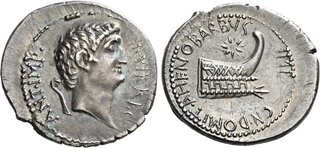| Numismatica Ars Classica > Auction 143 | Auction date: 7 May 2024 |
| Lot number: 427 Price realized: This lot is for sale in an upcoming auction - Bid on this lot  | Show similar lots on CoinArchives Find similar lots in upcoming auctions on |
| Lot description: The Dioscuri Collection. The Roman Republic. Marcus Antonius and Cn. Domitius Ahenobarbus. Denarius, mint moving with M. Antonius 40, AR 20 mm, 3.82 g. ANT·IMP·AVG III VIR·R·P·C Head of M. Antonius r.; behind, lituus. Rev. CN·DOMIT· AHENOBARBVS ·IMP Prow r.; above, star. Babelon Antonia 56 and Domitia 23. C 10. Sydenham 1179. Sear Imperators 258. RBW 1805. Crawford 521/2. Very rare and in exceptional condition for the issue, undoubtedly among the finest specimens known. A superb portrait of excellent style and a wonderful cabinet tone. Extremely fine / good extremely fine Ex Roma Numismatics sale XV, 2018, 426. A great many coins were struck for Marcus Antonius, and if anything they prove he was not selfish on this account. He allowed, for example, his naval commander Gnaeus Domitius Ahenobarbus to strike some highly personalised types, and he struck coins with portraits of Divus Julius Caesar, Octavian, the triumvir Lepidus, his youngest brother Lucius Antonius, his son Marc Antony Jr. and three of his four wives, Octavia, Fulvia and Cleopatra VII. After Brutus and Cassius were defeated at Philippi in October, 42 B.C., Ahenobarbus patrolled the seas until 40 B.C., when the political tide shifted and he allied himself with Marc Antony just when war between Antony and Octavian seemed imminent. Ahenobarbus proved a staunch ally, patrolling the Adriatic and the Ionian seas and aiding in a variety of efforts, including an attempt to defeat Sextus Pompey. The Treaty of Brundisium restored peace, Ahenobarbus was made governor of Bithynia and then witnessed Antony's disastrous campaign against the Parthians in 36 B.C., and in the following year helped capture the renegade Sextus Pompey. Having thus far survived the civil war, Ahenobarbus temporarily abandoned his naval duties to reside in Rome in 32 B.C. as one of the two consuls for the year. Since his colleague in the consulship, Sosius, was also an ally of Antony, they worked hard to censure Octavian. This backfired, though, and Octavian responded by occupying Rome and causing the two consuls and some 300 pro-Antony senators to seek asylum with Antony in Asia Minor. Ahenobarbus remained loyal to Antony until the bitter end, at which point, just before the battle of Actium took place on September 2, 31 B.C, when Ahenobarbus' health was suffering and he was not enthusiastic about throwing his lot in with Cleopatra, he defected to Octavian. He did not long survive, dying of natural causes late in 31, or early in 30 B.C. On this denarius the obverse is dedicated to Antony and the reverse is dedicated to Ahenobarbus. The reverse of this denarius, which bears a prow with a star above, is an obvious reflection of his status as a naval commander. It is of some interest that his design served as the prototype for coinages struck by the Flavians more than a century later. Estimate: 10000 CHF |  |



